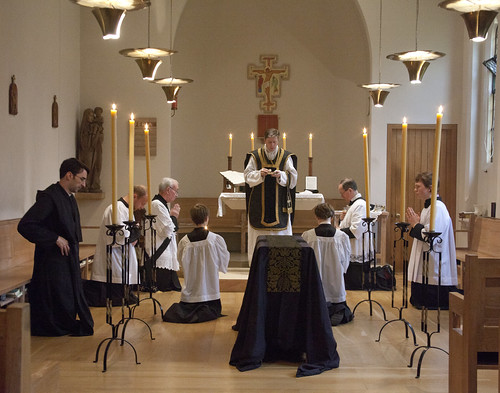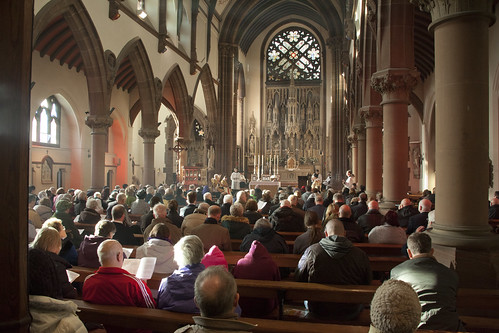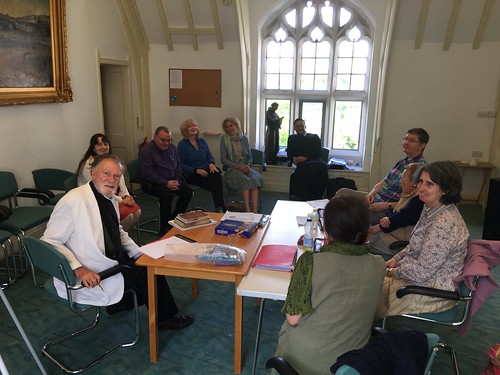Chairman's Blog
Protestantism and the cult of ugliness
Reposted from June 2014. A footnote to what I write here is an interesting fact I have since learned about 'Puritan' fashions: the Roundheads and Pilgrim Fathers and so on wearing black. The contrast between Roundheads and Cavaliers in the English Civil War derived from two different inspirations: the Cavaliers took their fashions from Catholic France, the Roundheads from the Protestant Netherlands. And where had the Netherlands got it from? Spain: a natural influence because of the Spanish control over much of it. This is of course an historical irony, but even in its Catholic origin it was a statement about rejecting frivolity and licentiousness. (See this section of a Wiki article.)
-----------------------------------------------------------------------
 |
| This is both ugly and glamorous. |
Continuing our series on a Catholic approach to fashion, I interrupt the posts of Queen of Puddings with a little philosophical interlude. I promised to say something about how the Protestant attitude is different from the Catholic, something referred to (without being developed) by Tracey Rowland.
Our inveterate commenter 'Eufrosnia' wants to know if there is anything wrong with dressing in an ugly way. Of course there is.
1. Ugliness is a natural evil. (Will anyone disagree with this?)
2. To embody it is bad. (This just follows from 1)
3. To do so deliberately or through negligence is morally bad. (This just follows from 2.)
To build an ugly building is wrong, if it is done deliberately or negligently (when it can be avoided without serious inconvenience). To dress in an ugly way is worse. It evinces a lack of gratitude to God for one's own creation, a lack of respect for oneself, and a contempt of others. There are even more fundamental issues involved here, as this post will argue.
 |
| The trouble with searching for 'Grunge' is that you get the fashion-industry imitation. The real thing is a street style and far more extreme. |
Dietrich von Hildebrand noted the unfortunate tendency in some of the more rigorist Catholic circles before the Council to disparage natural goods, because they had failed to distinguish them from worldly goods. Worldly goods, like money and worldly honours, have no intrinsic value. To set one's heart on them is to set one's heart on a vanity: on nothing. Natural goods, like beauty, have intrinsic value. Beautiful things were created good by God, or if man-made, they reflect His goodness. To reject natural goods is to reject the goodness of creation and its capacity to reflect God, and lead hearts to God.
Such a rejection is characteristic of Protestantism, and this forms the background, looking at the big picture, of the crisis of fashion we are living through. The Protestants taught that at the Fall nature human became depraved, evil, and by parallel the created world falls under suspicion. The Protestant attack on religious art did not limit itself to devotional images: it included Gregorian chant. Of course it is impossible to exclude the artful use of created things to raise the heart to God completely from religious architecture and liturgy, but Anglicans, Lutherans, Calvinists and Anabaptists settled at different points on this dismal road. The Anglicans smashed the stained glass and abolished the antiphons of Vespers and Compline. The Lutherans insisted that no syllable have more than one musical note. The Calvinists got rid of the organs. All of them created white-washed churches which look like neo-classical meeting rooms instead of holy places.
The Protestant mindset had it that to contemplate a devotional image - a crucifix, say - is to contemplate something other than Christ, to give to the image what we owe to Christ. It is idolatry. By extension, to contemplate any beautiful thing is to focus our attention away from God, onto something else. Something, in fact, which is worthless or even evil, because all created things have been tainted by the Fall.
The Catholic attitude is that by contemplating the crucifix we look beyond it, and raise our minds and hearts to the real Christ. By extension, any beautiful thing can raise the heart to God. Religious and devotional art, of course, expresses all sorts of specific truths, but all art which aims at beauty expresses the Catholic doctrine that God's creation is good even after the Fall. It lost Grace, and was wounded, by the Fall, but it did not lose all its value.
On clothing in particular, the more extreme Protestants adopted a sort of uniform of black and white, without colour or decoration, and with the simplest form. In fact this can look extremely elegant, but the logic of the position would suggest it should not please the eye at all.
Just as devotional images were thought to take the mind away from what they represented, it is easy to develop the idea that clothes distract one from the real person wearing them. The real thing, devotionally, is supposed to be something entirely spiritual: as if the Incarnation had never taken place. Similarly, the real thing in any material thing, including humans, might be thought to be something beneath and separate from the outward appearance. You can see this idea developing in the Enlightenment, in the writings of philosophers imbued with Protestant culture. This is essentially the Heresy of Formlessness which Martin Mosebach talks about, and I make no apology for mentioning this book again. Anyone interested in these issues should read it.
Applied to the liturgy you get the Novus Ordo. Applied to clothing you get grunge.
In reality, we are incarnated in our bodies, and we express ourselves in our clothes. Garments do not hide us: they clothe us.
FSSP Ordinations in Warringon
Next weekend two seminarians of the Priestly Fraternity of St Peter (FSSP) will be ordained to the priesthood in their impressive church of St Mary's, Warrington by Archbishop McMahon. Everyone is welcome to this historic events: the first ordinations in England using the traditional rites since the liturgical reform.
Support the work of the LMS by becoming an 'Anniversary Supporter'.
Institute of Christ the King to open a school in Preston, England
This was noted in their newsletter of last weekend. It seems they have a building for the school, which is often a big obstacle to opening a school.
The Institute of Christ the King Sovereign Priest has a very successful, highly professional, bi-lingual school in Belgium, the Brussels International Catholic School, with the energetic English priest of the Institute, Canon William Hudson as headmaster. It is wonderful news that the Institute is starting something in England; I wish them luck.
Support the work of the LMS by becoming an 'Anniversary Supporter'.
Book now for the LMS Latin Course: 24-28 July
Latin is the doorway to a full appreciation of Catholic culture, spirituality, liturgy, history, theology and law. St John Paul II told young people:
Let them realise that this remark of Cicero (Brutus 37, 140) can be in a certain way referred to themselves: ‘It is not so much a matter of distinction to know Latin as it is disgraceful not to know it.’ (Address to the Latinitas Foundation, 27th November 1978)
Don't miss out on the Latin Mass Society's intensive, residential Latin Course, which takes place from Monday to Saturday, 24th to 28th July. Book online here.
Teaching takes place at the Fransiscan Retreat Centre, Pantasph; we have block-booked the convenient and comfortable St Winefride's Guest House in Holywell down the road, run by Bridgettine sisters, for students. Students can also arrange their own accomodation.
We have kept prices down to a minimum: the headline cost, including accomodation, is £340 (+ £80 optional single room supplement).
It is half price for clergy and seminarians, including those about to enter seminary. There is a 10% discount for LMS members: you can join when you book and save money.
The course is taught by Fr John Hunwicke and Fr Richard Bailey, expert and highly experienced priest tutors. There is Mass every day, usually High Mass, with the St Catherine's Trust Summer School, in the Pugin church of St David at Pantasaph.
Priest students can say private Masses before breakfast in the parish church at Holywell next to their accomodation, in the Form of their choice; many over the years have taken part in High Mass at Pantasaph, for example learning how to be deacon or subdeacon.
You won't find a cheaper or more agreeable way to learn the 'Church's language' (as Pope Benedict called it). Read the FIUV Position Paper on Latin in Seminaries here. Book online here.
Support the work of the LMS by becoming an 'Anniversary Supporter'.
On hat-doffing, in the Catholic Herald
 |
| A Roman sacrifice: the (male) priest has covered his head. |
This weekend I have a letter in the Catholic Herald about hats.
I've written about headcoverings in church here, and the decline of hats in fashion here.
 What I didn't mention in the letter is that the view I put forward in it, which I think is overwhelmingly plausible--that the discipline on head-coverings in the primitive Church was at the time a counter-cultural sign, as a reversal of Jewish practice--contradicts the standard narrative explaining why Catholic women are no long obliged to cover their heads in church today. This view found its way into the 1976 Instruction of the CDF, Inter insignores: that St Paul's stern demand that what he describes as a universal custom among Christians was 'probably inspired by the customs of the period', or, more simply, was a 'cultural fact'.
What I didn't mention in the letter is that the view I put forward in it, which I think is overwhelmingly plausible--that the discipline on head-coverings in the primitive Church was at the time a counter-cultural sign, as a reversal of Jewish practice--contradicts the standard narrative explaining why Catholic women are no long obliged to cover their heads in church today. This view found its way into the 1976 Instruction of the CDF, Inter insignores: that St Paul's stern demand that what he describes as a universal custom among Christians was 'probably inspired by the customs of the period', or, more simply, was a 'cultural fact'. Inter insignores is a desperate attempt to stop post-Vatican II 'updating' throwing the baby out with the bathwater. The CDF wanted to argue that some of what St Paul and the New Testament in general said about the differences between the sexes was culturally-conditioned and could be ignored, but other things are of perennial and fundamental importance. It is a tricky argument to make, because what St Paul says about male headship and women covering their heads is so much more emphatic and theologically grounded than anything in the New Testament about women not being allowed to be priests. Indeed, if you want to construct a scriptural argument against female ordination, a topic not explicitly addressed anywhere in the canon, what St Paul says about the roles of the sexes is going to have to be your starting point: there is really nothing else.
Inter insignores is a desperate attempt to stop post-Vatican II 'updating' throwing the baby out with the bathwater. The CDF wanted to argue that some of what St Paul and the New Testament in general said about the differences between the sexes was culturally-conditioned and could be ignored, but other things are of perennial and fundamental importance. It is a tricky argument to make, because what St Paul says about male headship and women covering their heads is so much more emphatic and theologically grounded than anything in the New Testament about women not being allowed to be priests. Indeed, if you want to construct a scriptural argument against female ordination, a topic not explicitly addressed anywhere in the canon, what St Paul says about the roles of the sexes is going to have to be your starting point: there is really nothing else.
To reiterate the point about the historically indefensible idea that the head covering rules were 'culturally conditioned', St Paul says that men should uncover their heads, and women cover them. In Jewish practice men's head-coverings were far more important than women's: and still are. In ancient Greek custom (to generalise) neither men nor women covered their heads in cultic contexts, though both could wear garlands of flowers. Anyone can see for themselves scores of depictions of sacrifices on Greek vases from a Google image search. In ancient Roman custom men or women who actually carried out a sacrifice covered the head, but no one else did (apart from those garlands): again, the are scores of ancient depictions which underline the point. There simply is no contemporary cultural practice corresponding to St Paul's rules.
Sir,
 Laura Cathcart (Feature, May 26) is correct that men should take off their hats indoors, but this is a very recent custom. Prints and paintings confirm that men of the 18th and even 19th centuries thought nothing of wearing hats in coffee houses. Hat-wearing in the houses of Parliament was so widespread it became part of procedure. Only the Highest Anglicans took hats off to visit churches; earlier, Puritans had doffed them to pray, but replaced them to hear the sermon. The general rule of no men's hats indoors may owe something to the end of the 'Little Ice Age', which lowered temperatures from the 16th to 19th centuries, with a number of consequences for fashion.
Laura Cathcart (Feature, May 26) is correct that men should take off their hats indoors, but this is a very recent custom. Prints and paintings confirm that men of the 18th and even 19th centuries thought nothing of wearing hats in coffee houses. Hat-wearing in the houses of Parliament was so widespread it became part of procedure. Only the Highest Anglicans took hats off to visit churches; earlier, Puritans had doffed them to pray, but replaced them to hear the sermon. The general rule of no men's hats indoors may owe something to the end of the 'Little Ice Age', which lowered temperatures from the 16th to 19th centuries, with a number of consequences for fashion.Support the work of the LMS by becoming an 'Anniversary Supporter'.
Can non-Latinists pray the Latin Mass?
Reposted from Feb 2016
 |
| Eloquent gestures and expressive ceremonies in the Traditional Requiem Mass. |
Dr Robert Kinney (his doctorate is in Pharmacy, interestingly) has argued over at the Homiletic and Pastoral Review that is it impossible actually to pray in a language one does not understand, or with a celebrant who is using a language one does not understand.
[A]s Catholics, we believe that the Mass is the most powerful prayer on earth. If the Mass is said in an unfamiliar or entirely unknown language, though, can it properly be labeled as a “prayer”? Or, are the words uttered merely beautiful-sounding syllables without willed meaning?
This would have some pretty radical implications for Catholics visiting foreign countries and Masses celebrated for international congregations: in Lourdes, for example, it is common to find Masses celebrated in several languages, one lection in German, one in English, a prayer in French, another in Italian, and so on. The thought 'they'd be better off using Latin' is one which Dr Kinney presumably shares, since praying just a snatch of the Mass, or hearing just one lection meaningfully, must count as almost pointless.
It also implies that the silent prayers (the 'priestly prayers', such as the Lavabo) of the Novus Ordo are so much mumbo jumbo, even when Mass is celebrated in the congregation's mother tongue. If you can't hear the prayer, you can't understand it, right? As so often, attacks on the Traditional Mass rebound on the 1970 Missal. That Bugnini and Pope Paul VI: they got it all wrong, eh, Dr Kinney?
There is an interesting response to this article over at One Peter Five, which accepts the implication that we should familiarise ourselves with Latin. We should, of course, and you can sign up for the LMS intensive, 5-day Latin Course in July here. But Dr Kinney's argument fails at a more fundamental level.
The real problem with the argument is that he hasn't thought through what 'willed meaning' (and various equivalent phrases in the article) means. The Canon of the Mass, specifically, and the Mass as a whole, is an offering of Christ's Sacrifice on the Cross to the Father in reparation for the sins of mankind. That is a fact which can be inferred from the texts, though such an inference would take a bit of study and effort (particularly, perhaps, in the Novus Ordo), but in any case it should be and, particularly in the context of the Traditional Mass, commonly is, conveyed by preaching and catechesis. If you understand this fundamental meaning of the prayers of the Canon, then you can make this, the fundamental intention of the prayers, your own as you participate at Mass. Thus, as far as the most important meaning of the prayers is concerned, you do understand, and you do pray.
This can be done without a great deal of articulation. Someone without much catechism, who is familiar with the ancient liturgy (less so with the Novus Ordo, perhaps) will be able instinctively to grasp that what is going on is an act of worship. We can imagine such a realisation, for example, even by a non-Christian familar with pagan forms of worship, who encounters the Mass for the first time. Such a person would be correct: the offering of Christ's sacrifice is indeed the supreme act of worship. That degree of understanding is enough for the participant to will the act of worship with the priest. This is what we call the uniting of intentions: what we should do in Mass, is offer the worship together with the priest. Moving beyond the pagan's realisation that it is worship, we intend to associate ourselves with it.
No doubt Dr Kinney will object that, while this may be true at the most general level, many liturgical texts have specific intentions and messages, and ignorance of Latin can be a barrier to making these specific intentions our own. It is true that there are specific intentions and meanings in specific texts, but it is not true that missing out on some of these undermines the validity of our union with the most fundamental and important intention and meaning of the Mass. At least, Dr Kinney had better hope it isn't, because there is really no reason to imagine that this is a bigger problem for a non-Latinist who regularly attends the Traditional Mass, than a non-theologian who regularly attends the Novus Ordo being celebrated in his or her own cradle language.
The ceremonies of the Traditional Mass use a set of symbolic gestures, such as incensing, sprinkling with Holy Water, signs of the cross, and kisses, which any reasonably attentive regular worshiper will pick up and understand without needing much prompting. For example, the priest kisses the Gospel book after reading it: you don't need a degree in liturgical studies to understand that this is an act of reverence and love.
On the other hand, liturgical prayers and passages of scripture do contain some fairly complex theological ideas, whatever language they are declaimed in. In some ways the texts of the Novus Ordo are simpler than those of the Traditional Mass, but in other ways they are harder, because in order to understand them fully one needs to read them in a theological context which isn't provided in the liturgy itself: they require catechesis - instruction outside the liurgy - to understand them properly. But don't take my word for it.
On Communion in the Hand, from Memoriale Domine:
It is, above all, necessary that an adequate catechesis prepares the way so that the faithful will understand the significance of the action and will perform it with the respect due to the sacrament. The result of this catechesis should be to remove any suggestion of wavering on the part of the Church in its faith in the eucharistic presence, and also to remove any danger or even suggestion of profanation.
On Reception under Both Kinds, from Redemptionis Sacramentum
So that the fullness of the sign may be made more clearly evident to the faithful in the course of the Eucharistic banquet, lay members of Christ’s faithful, too, are admitted to Communion under both kinds, in the cases set forth in the liturgical books, preceded and continually accompanied by proper catechesis regarding the dogmatic principles on this matter laid down by the Ecumenical Council of Trent.
On receiving Communion standing, from the General Instruction of the Roman Missal (American edition)
The norm for reception of Holy Communion in the dioceses of the United States is standing. Communicants should not be denied Holy Communion because they kneel. Rather, such instances should be addressed pastorally, by providing the faithful with proper catechesis on the reasons for this norm.
The Novus Ordo, as usually celebrated, is just terribly confusing. The confusion undermines the proper understanding of the prayers and ritual actions, which, Dr Kinney must surely worry, can render impossible the congregation's praying along with the liturgy.
Dr Kinney must be even more worried over the mistranslations of the Missal, so many of which were exposed for all to see in the debate about the improved English translation finally promulgated in 2011. From 1974 to 2011 the faithful were given liturgical texts which failed to express adequately the mind of the Church. This must, I suppose, have prevented them from praying the Mass.
Finally, Dr Kinney must be besides himself with concern over the way that the three-year lectionary regularly serves up as lections in the Mass passages from the Sacred Scriptures which are obscure, not to say incomprehensible. The Traditional One Year cylcle tends not to do this.
Not for the first time, it falls to me to defend the Ordinary Form of the Mass from opponents of the Extraordinary Form. The reality is that a grasp of the fundamental meaning of the Mass is sufficient to allow the worshipper to unite himself with the fundamental intention of the Mass. A good understanding of the specific meanings of parts of the Mass and the texts proper to particular feastdays is to be heartily commended, but is not absolutely necessary. After all, even a lifetime's study of the texts and ceremonies of the Mass (in either Form) will not exhaust their meaning, or eliminate all controversy among scholars, just as a lifetime's Biblical scholarship will never uncover the whole meaning of the Sacred Scriptures.
It does appear to be the case, however, that the drama of the Traditional Mass does a better job at conveying the central meaning of the Mass to the Faithful than translation into the vernacular does for the Novus Ordo. At any rate, this survey of church-going American Catholics found that only half of them realised that the Church taught the Real Presence. That is clearly a mistake which is less easy to make if you attend the Traditional Mass.
For why the use of Latin actually assists the faithful, even those ignorant of Latin, to participate in the Mass, see here.
Support the work of the LMS by becoming an 'Anniversary Supporter'.
Protecting people against bad ideas
 |
| John Stuart Mill |
Like everyone else involved in universities and schools, I have had to undergo training on dealing with students who might be at risk of 'radicalisation', as part of the Government's 'Prevent' strategy. In fact I think anyone can access and do this little on-line course. There has been a lot of criticism of the Government's policies in this area, but this aspect at least seems pretty sensible. It contained some important insights into how people are drawn into dodgy groups, which correspond with what I have read about recruitment done by cults, which is of course a pretty close parallel to what is happening. I can't comment on other aspects of Government policy, but I'm not uncomfortable with what I am myself being asked to do as a university tutor. It just looks like good practice: a matter of being concerned with student welfare.
Support the work of the LMS by becoming an 'Anniversary Supporter'.
YouTube Video from Roger Buck
Having read two books by Roger Buck, and had some email correspondance with him, it is rather interesting to see him in the flesh, so to speak, on video, for the first time.
My posts about his books:
The lovely Gentle Traditionalist, suitable for non-Trads and indeed non-Catholic readers.
The longer Cor Jesu Sacratissimum: From Secularism and the New Age to Christendom Restored, detailed critique of the New Age, partly autobiographical, and a plea for the restoration of Europe.
Support the work of the LMS by becoming an 'Anniversary Supporter'.
Eucharisticum Mysterium: blog post for the Catholic Herald
The Catholic Herald has published a post of mine on the 50th anniversary of one of the documents preparing the way for the Novus Ordo Missae. The highlight of the document is the evolving attitude to concelebration.
 |
| Simultaneous Low Mass at the LMS Priest Training Conference in Prior Park, |
Today is the 50th anniversary of the Instruction Eucharisticum Mysterium, signed by both the Prefect of the soon-to-be abolished Sacred Congregation of Rites, and the President of the Concilium, the temporary institution in charge of the liturgical reform. It now represents a fascinating snapshot of a fast-moving action sequence.
Support the work of the LMS by becoming an 'Anniversary Supporter'.
New book on the Third Secret of Fatima
 Kevin Symonds, whose book on the composition of the Prayer to St Michael I recommended on this blog back in 2015, has written another careful, thorough, and sober study of a subject surrounded by conjecture: the 'Third Secret' of Fatima.
Kevin Symonds, whose book on the composition of the Prayer to St Michael I recommended on this blog back in 2015, has written another careful, thorough, and sober study of a subject surrounded by conjecture: the 'Third Secret' of Fatima.
Get it from Amazon.co.uk
I've provided a publicity-blurb for it as follows:
Symonds has done a very thorough job in getting to the bottom–insofar as it is possible–of the various confusions and conspiracy theories on the subject of the Third Secret, making a compelling case that what the Vatican published in 2000 was the whole text of it as written by Sr Lucia. No doubt the debate will continue, but the clarity and intellectual honesty of Symonds’ work, with copious reference to the relevant sources in their original languages, will be of enormous assistance for scholars in the future who wish to understand this tangled affair. –Dr. Joseph Shaw
I hope my regular readers won't be put off the book by the fact that, after exhaustive investigation of how each claim has come to be made and how the evidence stacks up, Symonds concludes that the various conspiracy theories to the effect that the Third Secret was not really revealed by the Vatican when the vision of the martyrdom of the 'bishop dressed in white' was finally published, fail: that is, that the Vatican really did publish everything they had.
I have read various things in support of these theories which, at the time, I found convincing, but Symonds shows, with painstaking detail, that there is less to these than meets the eye. Whatever you may want to believe, this book really must be taken into consideration.
He doesn't address the question of whether the Consecration of Russia has been done.
All the stuff about the alleged length and physical shape and alarming contents of the letter sent by Sr Lucia with the secret in it are considered, and it gets rather complicated. There is a larger and more earthy question, however, which used to worry me: if the secret was as un-explosive as the Vatican revealed it to be, why was it not published earlier? Symonds gives the following answer. Since the vision of the 'bishop dressed in white' appears to be a prophecy of the assassination of a pope, to have published it much earlier would have been for the Vatican to say, in effect, that they expected such an event to take place. It would have been like putting a target on the Pope's back: a challenge to every nutcase and hostile government on the planet to kill the Holy Father. Only insofar as they were able to say that, with hindsight, the vision was about the attempted assassination of Pope John Paul II in 1981, and more especially after the fall of Communism, could it be published without this kind of worry.
Get it from Amazon.co.uk
Support the work of the LMS by becoming an 'Anniversary Supporter'.






